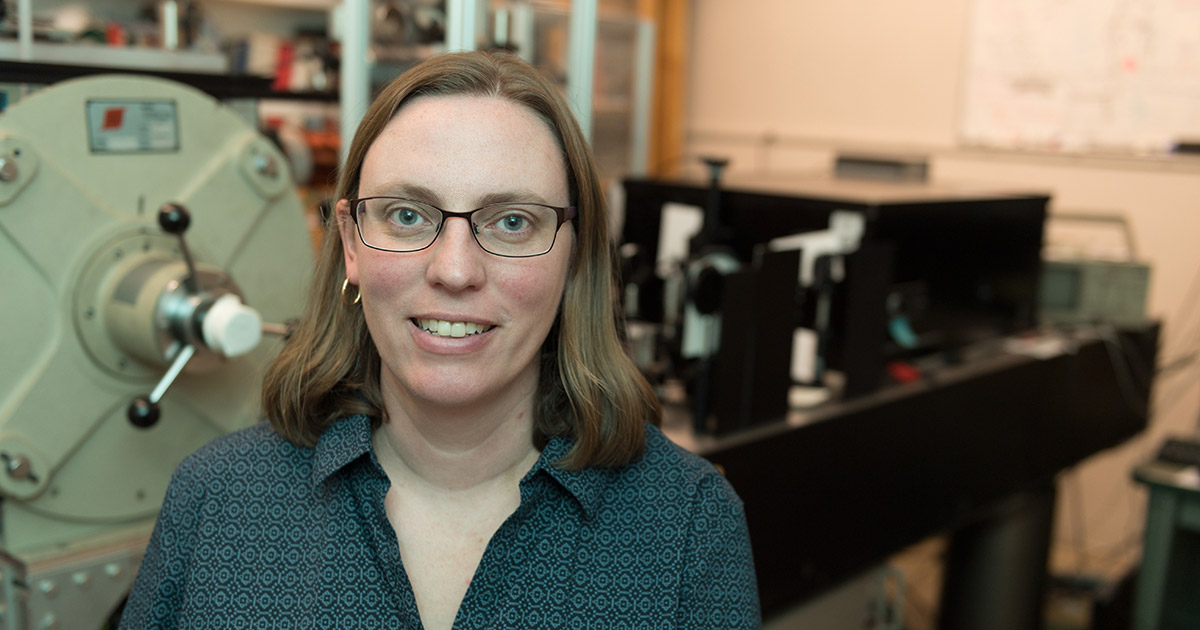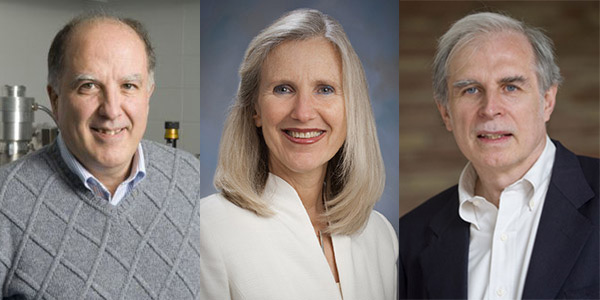
Kristen Buchanan, associate professor in the Department of Physics, and lead investigator on a new grant from the W. M. Keck Foundation.
The next big advances in computer memory, digital storage and other electronics are going to come from very small places: the spins of individual electrons.
The manipulation of electron spin – the phenomenon that exploits the magnetic fields of each electron as it spins like a top – is an emerging frontier in quantum physics called spintronics. Colorado State University researchers think they have what it takes to provide unprecedented control of these spinning tops, which are essentially bits of information. They’ll do it by finding new ways to make, measure and control ripples that can be launched through magnetic materials, better known as spin waves. Scientists have proposed and simulated, but not yet realized, various concepts for novel, nanoscale spin wave circuitry.
Generating spin waves with uncommonly short wavelengths, and developing a first-of-its-kind, tabletop soft X-ray microscope to see and study these waves, are the ambitious goals of a new project funded by the W.M. Keck Foundation. A CSU research team led by Kristen Buchanan, associate professor of physics, has received a three-year, $1 million grant to revolutionize nanoscale electronics using the phenomenon of spin waves as a means to transmit signals. If they are successful, they will lay the groundwork for low-power, non-volatile storage of electronic information, or applications like quantum computers and nanoscale oscillators.
“Magnetic materials have already had a huge impact on society through microwave electronics, sensors, and magnetic storage devices,” Buchanan said. “The physics of magnetic materials is quite rich, and there is a lot of potential that is so far untapped to look for new ways to transmit and process information.”
Buchanan leads a research group at CSU that makes spin waves and uses light to study them. But the researchers are limited in the length scales they can study by how tightly they can focus their light to see them. The funding from the Keck Foundation will enable them to extend their scientific reach to the nanoscale.
Joining Buchanan in the Keck-funded effort will be electrical and computer engineering professors Carmen Menoni (Ph.D. physics, ’87), Jorge Rocca (Ph.D. electrical engineering, ’83) and Mario Marconi. Rocca will lead the development of a new, short-wavelength, tabletop X-ray microscope that is designed specifically to detect spin waves with wavelengths in the 10-to-20 nanometer regime – an order of magnitude shorter than Buchanan can see with her existing spin wave detection system. Such precision from a new X-ray microscope would allow the researchers to uncover fundamental, never-before-observed details of spin waves.

Professors Mario Marconi, Carmen Menoni and Jorge Rocca.
Together with Rocca’s decades of experience developing short-wavelength, bright laser sources, Menoni and Marconi will provide expertise in X-ray optics and imaging. Their knowledge, combined with Buchanan’s expertise in magnetic materials, will uncover answers to vital scientific questions about generating and controlling spin waves.
One of the ideas the researchers will explore is using magnetic domain walls as a platform for nanoscale, spin wave-based devices. Domain walls are the interfaces between magnetic moments. The researchers theorize that these “walls” could serve as wire-like channels for the spin waves, eliminating roughness issues associated with patterned wires, and making the new wires easily reconfigurable and rewriteable.
The Keck Foundation is known for supporting high-risk projects with potential for big scientific payoff – projects that are difficult to find funding for otherwise. The CSU team’s unique blend of expertise in magnetics, X-ray science, optics and imaging provides an ideal platform for probing fundamental questions about the emerging scientific area of spintronics, Buchanan said. The CSU-based collaboration will allow the team to maintain flexibility as they work together, adjusting their modeling or experimental approach as needed, and working at a more rapid pace than would be possible otherwise.
Buchanan also pointed to the rich collaborative nature of magnetics research at CSU and throughout the Rocky Mountain region, bolstered by the Center for Advanced Magnetics, a Program of Research and Scholarly Excellence established by the Office of the Vice President for Research. The researchers plan to continue networking with other institutions and exploring new avenues for scientific inquiry through the research activity the Keck Foundation is now supporting.
High-potential research
The Keck Foundation has a long history of supporting CSU science. For example, chemists Amy Prieto and Jamie Neilson were awarded a grant in 2016 for their work in designing new, functional materials. The Keck Foundation also supported Rocca’s initial efforts in extreme ultraviolet lasers over a decade ago. This enabled him to establish the NSF Center for Extreme Ultraviolet Science and Technology and build a leading program in extreme ultraviolet and X-ray laser technology.
Based in Los Angeles, the W. M. Keck Foundation was established in 1954 by the late W. M. Keck, founder of the Superior Oil Company. The foundation’s grant-making is focused primarily on pioneering efforts in the areas of medical research, science and engineering and undergraduate education. The foundation also maintains a Southern California Grant Program that provides support for the Los Angeles community, with a special emphasis on children and youth. For more information, visit www.wmkeck.org.